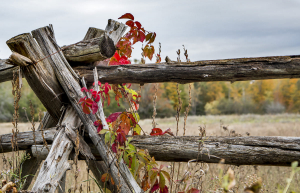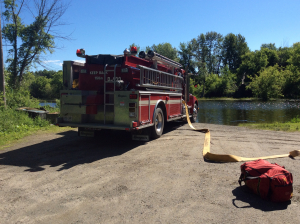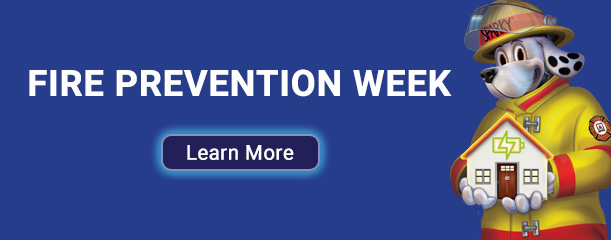Super User
Animal Control
All Animal Control complaints should be directed to Frontenac Municipal By-Law Services at 613-541-3213.
Lanark Highland’s Dog Pound is located at – 810 Pelton Road, Kemptville; Phone: 613-204-7479
Dog Licences
The Townships Animal Control By-Law # 2004-502 provides for the annual licencing, regulating and registering of all dogs and imposes a licence fee on all dog owners.
Fees
| Application Type | Fee |
|---|---|
| Dog Tag | |
| Jan 1 - Mar 31 | $15.00 |
| Apr 1 - Dec 31 | $30.00 |
| Licenced Hunting Dog | $5.00 |
| Micro-chipped Dogs | $5.00 |
| Replacement Tag | $2.00 |
| Guide Dog / Service Dog | FREE |
| Kennel Licence | $50.00 |
| Aggressive Dog Licence | $1000.00 |
Purchase a Tag
In Person
Complete the Dog Licence Form and submit it at the Township Office during regular office hours. Dog Tags can be purchased using cash, cheque or debit.
By Mail
Complete the Dog Licence Form and send the form along with a self-addressed stamped envelope and a cheque made payable to the Township of Lanark Highlands. A copy of the Micro-chip papers and/or MNR Hunting Dog Licence must also be sent, if applicable.
- Licenced hunting dogs require a valic MNR licence
- Micro-chip papers must be provided in order to obtain a micro-chipped dogs licence
- Micro-chipped dogs are required to be registered and wear a valid dog tag
Animal Control Services enforce the Regulate the Keeping and Control of Animals(To Regulate the Keeping and Control of Animals) and Regulate the Keeping and Control of Animals - Amended which make owners responsible for their pet’s actions, helps return lost pets to their owners and ensures pets are a positive addition to the community.
An animal shall be deemed to be running at large if found any place other than the premises of the owner and not under the control of any person. The Animal Control Officer may seize any animal found running at large in the Township and cause such animal to be impounded or returned to the owner.
Owners of a dog shall take all precautions necessary to prevent the dog from barking in order to not disturb the peace and quiet of any residence or persons in the vicinity.
Dog owners must pick up after their pet. Owners of a dog who allow waste to be placed on public property or private property not owned by the dog owner are liable to a fine.
The Dog Owners Liability Act (DOLA) requires that ALL Pit Bulls be spayed/neutered, on a leash of no more than 1.8 metres in length, and muzzled when off the property of the owner. When on the property of the owner, the property must be securely enclosed to prevent the pit bull from breaking out of the property.
Pit bulls can be seized by Animal Control if it is felt they are behaving in a menacing manner, have bitten or attacked a person or animal, or are considered to be a Prohibited Pit Bull (i.e. one that has not been spayed/neutered).
It is illegal to give away or sell Pit Bulls or their puppies in Ontario. The only agencies that can sell or give away these dogs are pounds and shelters.
Failure to comply with the Dog Owners’ Liability Act (DOLA) could result in charges or the dog could be ordered destroyed. For a copy of the DOLA or further information please visit www.e-laws.gov.on.ca
Spaying/Neutering can help to prevent your pet from wandering, and reduces the risk of many diseases. Every year unwanted animals end up in municipal pounds, cared for at public expense. If you are unable to keep your dog/cat, call Animal Control or your local pound or shelter. Please do not leave these animals to fend for themselves. This practice is inhumane and against the law.
Animal Control and Animal Cruelty are two different agencies. When considering which agency to call consider this - Animal Control protects people from animals, Cruelty Agents (OSPCA) protect animals from people. If you suspect animal cruelty or neglect, please call the Ontario Society for the Prevention of Cruelty to Animals (OSPCA) at 613-310-7722.
Keeping your flock safe from predators is critical. Information on preventative measures and compensation after the fact can be found on the Ministry of Agriculture, Food and Rural Affairs website at www.omafra.gov.on.ca or by calling 1-877-424-1300.
If you are the owner of livestock or poultry and have suffered a loss of livestock due to predation by a coyote, wolf or stray dog please call the Livestock Evaluator.
Contact Information
Livestock Evaluator, Ross Creighton
613-256-4752
The Bear Wise Program teaches people about black bears as well as things they must do to keep bears away from urban and semi urban areas. For more information, visit the Bear Wise Program.
Administrative Services
Commissioner Of Oaths
A number of staff members, by virtue of their office, are "Commissioners of Oaths". If you require the service of a Commissioner of Oaths, please call to make an appointment to ensure the availability of a Commissioner.
Once an appointment is scheduled, you must come to the Municipal Office in person and sign the affidavit in front of the Commissioner. You must provide one original piece of government issued identification (no photocopies permitted) that includes your photo and signature (ex. valid driver's licence, passport, etc.) There is a fee of $5.65 for this service.
A Commissioner of Oaths is not the same as a "Notary Public". A Notary Public is a person who is authorized under the Notaries Act to do various things, including commission documents, certify documents as true copies and to verify signatures. If you require the services of a Notary Public, please contact a Lawyer's Office.
Freedom of Information
The Municipal Freedom of Information and Protection of Privacy Act (MFIPPA) provides individuals with the right to access certain records and personal information under the custody and control of the Township. The purpose of the MFIPPA is two-fold; providing access to information and protection from access to information in certain specific instances.
Please contact the Clerk's Department for assistance. In most cases, information is made readily available to the public and you won't need to make a formal request. The municipality may in some cases restrict access to certain documents to protect individual privacy or the public interest.
For more detailed information please contact the Township Office or visit the Office of the Information & Privacy Commissioner of Ontario at www.ipc.on.ca.
You can print a copy of the application form by clicking here: MFIPPA_-_Access_Request_Form.pdf
Lottery Licence
"Charitable gaming" refers to lottery schemes permitted by a licence under the Criminal Code of Canada. Typically these may include bingos, raffles, break open tickets and social gaming events held by charitable and religious organizations. Charitable organizations are regulated by licencing policies and the terms and conditions of the licences issued by the province or municipalities under authority of an Order-in-Council.
Canada's Criminal Code only permits charitable and religious organizations to conduct lottery schemes to raise funds pursuant to an issued lottery licence. Organizations must have a demonstrated charitable or religious mandate to qualify. The courts have determined that the term "charitable" refers to organizations which provide programs for:
- the relief of poverty;
- the advancement of education;
- the advancement of religion; and
- other charitable purposes beneficial to the community.
The following are prerequisites to be considered eligible for a lottery licence:
- Organizations must have been in existence for at least one (1) year;
- Organizations must have a place of business in Ontario;
- Organizations' primary purpose must be to provide charitable services in Ontario; and
- Organization must use the proceeds of any lottery scheme for objects or purposes which benefit Ontario residents.
The primary purposes of an organization are determined by considering:
- the mandate of the organization as set out in its' incorporation documents or documents stating the organization's objectives;
- the objectives of the organization as described in its' application for licence; and
- the services which have actually been provided by the organization to the community.
Under Order-in-Council 2688-93, municipalities may issue licences to conduct the following lottery schemes:
- Bingo events with prize boards $5,000 and under;
- Media bingo events;
- Raffle lotteries for total prizes $50,000 and under;
- All break open ticket lotteries not licenced by the provincial office; and
- Bazaars (Bingo maximum $500; Raffle maximum $500; maximum 3 wheels of fortune).
- Determine what type of lottery scheme your organization intends to conduct;
- Obtain the appropriate application form from your local municipal office or the province; and
- Complete the form according to the instructions on the form and the policies provided by the municipal office or as set out in the guide for that lottery event and submit it along with the applicable licence fee to the municipal office.
First time applicants should, in addition to the materials required with the application as identified in the lottery licencing policies, provide the following information or documents:
- A copy of the articles of incorporation or constitution and/or by-laws.
- A copy of the budget or financial statements for the preceding and coming years.
- Any other information that will assist in determining the charitable nature of the objects and purposes. This could include an annual report, charitable number for income-tax purposes and the fact that it meets the reporting requirements of the Charities Accounting Act.
- The proposed use of proceeds must be consistent with the primary objects and purposes of the organization which must be of a charitable nature consistent with at least one of the four classifications of charitable purposes.
The types of organizations which cannot be considered charitable include:
- social clubs.
- professional associations, unions, employee groups.
- elected representative groups including municipal, regional, provincial and federal governments.
- government ministries, agents or bodies.
- political lobby groups.
- political parties.
- adult hobby groups.
- private sports clubs (e.g. golf/curling).
- adult sports teams.
- Bingo & Media Bingo:3% of total prize board.
- Raffle: 3% of total prize value.
- Break Open Tickets: 3% of prize value per box.
- Bazaar: 3% of prize value for bingo or raffle; $10/wheel.
For organizations that have previously held a municipal lottery licence, forty-eight (48) hours is required from the time the completed lottery licence application and documentation are submitted to the municipal office, until the licence is issued. This will ensure efficient and accurate licencing of all organizations.
Lottery licencing for the Township of Lanark Highlands is a function of the Clerks’ Department. You may contact the municipal office with any questions.
Further information about lottery licencing and the Alcohol and Gaming Commission of Ontario may be obtained by visiting their website. The Lottery licencing Policy Manual may also be accessed by visiting their website.
Committees & Boards
A variety of committees and boards offer input and advice to Council on the issues that touch on their respective mandates. In addition, the Township of Lanark Highlands is represented by Council members on a number of external agencies, often along with their counterparts from neighbouring municipalities.
The Township encourages and enjoys committee participation by interested and informed citizens.
In municipal politics, the Committee of Adjustment (COA) is a quasi-judicial body responsible for making decisions regarding certain land-use applications, typically in relation to zoning bylaws and official plans. The committee has the authority to grant minor variances and consent applications (land severances), which are generally related to land-use or property development that do not conform to the established zoning regulations, but are deemed minor enough not to warrant a full zoning bylaw amendment.
Applications to the Committee of Adjustment will be processed in accordance with the requirements of Sections 45 and 53 of the Planning Act, applicable regulations (O.Reg. 200/96 and 197/96 as amended), the Statutory Powers Procedures Act and applicable Township policies.
Note: The committee holds public hearings, allowing neighbors and interested parties to provide feedback on the applications.
Their decision is based on the information presented at the hearing, which includes staff reports, public comments, and considerations for the broader community’s well-being.
Agendas & Minutes - Committee of Adjustment
Contact:
Nicole Guthrie, Clerk
Phone Number: 613-259-2398 ext 231
Sarah Hobbs, Planning, Building and Clerk Administrative Assistant
Email:
What is a Police Services Board
Many members of the Community have asked “What is the Police Services Board?” and “What do they do?”
The Lanark Highlands Police Services Board is comprised of: Councilor, Steve Roberts (Council Appointee), Michel Vermette (Municipal Appointee position).
The Lanark Highlands Police Services Board is one of seven boards which contract policing from the Ontario Provincial Police in Lanark County. Pursuant to the Police Services Act of Ontario, the following are the responsibilities of the Board:
- participate in the selection of the detachment commander of the detachment assigned to the municipality or municipalities;
- generally determine objectives and priorities for police services, after consultation with the detachment commander or his or her designate;
- establish, after consultation with the detachment commander or his or her designate, any local policies with respect to police services. However, the board or joint board shall not establish any policy that conflicts with provincial policy with respect to police services);
- monitor the performance of the detachment commander;
- receive regular reports from the detachment commander or his or her designate on disclosures and decision made under section 49 (secondary activities); and,
- review the detachment commander’s administration of the complaints system under Part V and receive regular reports from the detachment commander or his or her designate on his or her administration of the complaints system.
Along with the legislated duties, the P.S.B. is considered a bridge between the community and the police. The board takes an active role in hearing community concerns and addressing them with the Detachment Commander or his designate for action.
For meeting dates, agendas and minutes click here
FOR INFORMATION
Contact: Chelsea Rath, Lanark Highlands Police Service Board Secretary
Phone Number: 613-259-2398 ext 252
Email:
The Ontario Provincial Police (OPP) provide policing services to the Township on a contractual basis. If you have specific concerns or comments about the Police Services, please contact any member of the Police Services Board or the Interim Detachment Commander, Karuna Padiachi, at (613) 267-2626 ext 4410
The Lanark Highlands Recreation Advisory Committee consists of the following members:
- Marina Summers (Chair & Council Representative)
- Leigh Brown
- Susan Breckenridge
- Jan Kammersgaard
- Roger Young
For meeting dates, agendas and minutes click here
FOR INFORMATION
Contact: Chelsea Rath, Manager of Facilites/Community Affairs
Phone Number: 613-259-2398 ext 252
Email:
The joint planning committee oversees and co-ordinates activities and advocacy directed at the achievement of common goals which are consistent with the mission and vision of The North Lanark Community Health Centre and The Township of Lanark Highlands.
The joint planning committee shall consist of a minimum of two community members, two members representing the Township of Lanark Highlands and two members representing The North Lanark Community Health Centre. The Chair of the Board of Directors of Lanark Health & Community Services and the Mayor of the Township of Lanark Highlands are ex officio members.
The committee shall meet quarterly or at the call of the Chair and will be conducted at a time and place convenient to the members of the committee.
The Lanark Highlands Public Library Board consists of the following members:
- Tom Shoebridge
- Wayne Stryde
- Margaret Malfara
- Lindsey Rickan
- Gregory Drew
- Susan Athrens
- Deputy Reeve Bill King (Council Representative)
For meeting dates, agendas and minutes click here
There are eleven municipalities in the watershed represented on a 17 member Board of Directors. Central Frontenac, Addington Highlands, Greater Madawaska, Tay Valley, Beckwith, Carleton Place (2 members), Drummond/North Elmsley, Lanark Highlands, Mississippi Mills (2 members) , North Frontenac, City of Ottawa (5 members).
The role of the Board of Directors is to establish policies of the Authority, define programs and services to achieve its mandate, determine and monitor annual expenditures, direct management, and advocate the work of MVCA in their community.
Township of Lanark Highlands
MVCA Representative: John Hall
For meeting dates, agendas and minutes click here
MUNICIPAL GRANTS COMMITTEE MEMBERS NEEDED
The Township of Lanark Highlands is currently recruiting members for the Recreation Advisory Committee. The Committee will be composed of one member of council and four members of the public. The Committee will review and assess municipal grant applications submitted by proponents requesting municipal grant funding. Meetings will be held during the hours of 9:00am and 4:00pm Monday – Friday annually.
Terms of Reference and Application
To apply please email your application to:
Chelsea Rath, Manager of Facilities/Community Affairs – .
613-259-2398 ext.252
Deadline To Apply: November 28th, 2022 4:00pm
OR drop off your application in person at the Municipal Office –
Located at 75 George St. Lanark, ON.
Office hours are 9:00am-4:00pm Monday – Friday.
We look forward to working on the development of our community in a positive and collaborative environment.
For meeting dates, agendas and minutes click here
The Lanark County Climate Action Implementation Working Group provides direction for the implementation and reporting of Lanark County’s Climate Action Plan.
The purpose of the Climate Action Working Group is to:
• Provide direction to the implementation and monitoring of the Climate Action Plan (CAP)
• Provide reports and recommendations to County Council about climate action and the CAP
• Liaise and engage with the community, stakeholders, and lower-tier municipalities in Lanark County, and the Climate Network Lanark (CNL) Working / Advisory Groups about climate action and the CAP
• Assist, if needed, the lower-tier municipalities in Lanark County with their corporate CAP
• Respond to climate change concerns from the community by finding opportunities for climate action that address community concerns
• The committee will work to build a consensus on direction and recommendations for staff to present to the reporting Committee of the Whole meeting
The term of the Climate Action Working Group will continue for the remainder of this term of council.
As the structure of the Working Group requires involvement from each local municipality, the Township of Lanark Highlands is seeking interest for one (1) representative from the Township to sit on the Working Group.
If you are interested and would like to apply, please view the Terms of Reference and Application below.
Application Form Municipal Representative LC Climate Action Committee 2023
Climate Action Working Group Terms of Reference
The deadline to apply is February 27th, 2023, at 4:30 p.m.
Please forward all applications to:
Township of Lanark Highlands
Amanda Noel, Clerk
75 George St. Lanark, ON, KOG 1K0
613-259-2398 x 231
Role and Purpose of the Waste and Recycling Committee
The Lanark Highlands Waste Committee (LHWC) will provide waste diversion and efficiency advice, recommendations, and information to Council concerning waste issues related specifically to the Waste Master Plan, programs and projects that affect the municipalities waste component.
LHWC has no powers of either approval or veto over any decision, activity or program of the municipality.
Committee Structure
Composition
LHWC will consist of 6 members, including 1 member of Council and 1 member from the Public Works Department. The 4 remaining members will be appointed by Council and shall be residents of the Township of Lanark Highlands, representing a cross-section of our community with an interest or / expertise in waste related matters and ideally to have representation from the rural farm community, business community, professional community, residential community and youth community.
Waste and Recycling Committee Terms of Reference
The deadline to apply is July 24, 2024, at 4:00 p.m.
Please forward all applications to:
Township of Lanark Highlands
Chad Kean
Manager of Public Works
75 George St. Lanark, ON, KOG 1K0
613-259-2398 x 239
Plans, Studies & Reports
Waste Management Plan
2022 Final Waste Management Plan
Based on the document size of the Final Reports, the tables and appendices have been removed from the report to allow uploading to the Township website. Should any residents wish to have the appendices, please contact Public Works ( or ) and we will be able to provide.
test page
7The standard Lorem Ipsum passage, used since the 1500s
"Lorem ipsum dolor sit amet, consectetur adipiscing elit, sed do eiusmod tempor incididunt ut labore et dolore magna aliqua. Ut enim ad minim veniam, quis nostrud exercitation ullamco laboris nisi ut aliquip ex ea commodo consequat. Duis aute irure dolor in reprehenderit in voluptate velit esse cillum dolore eu fugiat nulla pariatur. Excepteur sint occaecat cupidatat non proident, sunt in culpa qui officia deserunt mollit anim id est laborum."
8Section 1.10.32 of "de Finibus Bonorum et Malorum", written by Cicero in 45 BC
"Sed ut perspiciatis unde omnis iste natus error sit voluptatem accusantium doloremque laudantium, totam rem aperiam, eaque ipsa quae ab illo inventore veritatis et quasi architecto beatae vitae dicta sunt explicabo. Nemo enim ipsam voluptatem quia voluptas sit aspernatur aut odit aut fugit, sed quia consequuntur magni dolores eos qui ratione voluptatem sequi nesciunt. Neque porro quisquam est, qui dolorem ipsum quia dolor sit amet, consectetur, adipisci velit, sed quia non numquam eius modi tempora incidunt ut labore et dolore magnam aliquam quaerat voluptatem. Ut enim ad minima veniam, quis nostrum exercitationem ullam corporis suscipit laboriosam, nisi ut aliquid ex ea commodi consequatur? Quis autem vel eum iure reprehenderit qui in ea voluptate velit esse quam nihil molestiae consequatur, vel illum qui dolorem eum fugiat quo voluptas nulla pariatur?"
91914 translation by H. Rackham
"But I must explain to you how all this mistaken idea of denouncing pleasure and praising pain was born and I will give you a complete account of the system, and expound the actual teachings of the great explorer of the truth, the master-builder of human happiness. No one rejects, dislikes, or avoids pleasure itself, because it is pleasure, but because those who do not know how to pursue pleasure rationally encounter consequences that are extremely painful. Nor again is there anyone who loves or pursues or desires to obtain pain of itself, because it is pain, but because occasionally circumstances occur in which toil and pain can procure him some great pleasure. To take a trivial example, which of us ever undertakes laborious physical exercise, except to obtain some advantage from it? But who has any right to find fault with a man who chooses to enjoy a pleasure that has no annoying consequences, or one who avoids a pain that produces no resultant pleasure?"
10Section 1.10.33 of "de Finibus Bonorum et Malorum", written by Cicero in 45 BC
"At vero eos et accusamus et iusto odio dignissimos ducimus qui blanditiis praesentium voluptatum deleniti atque corrupti quos dolores et quas molestias excepturi sint occaecati cupiditate non provident, similique sunt in culpa qui officia deserunt mollitia animi, id est laborum et dolorum fuga. Et harum quidem rerum facilis est et expedita distinctio. Nam libero tempore, cum soluta nobis est eligendi optio cumque nihil impedit quo minus id quod maxime placeat facere possimus, omnis voluptas assumenda est, omnis dolor repellendus. Temporibus autem quibusdam et aut officiis debitis aut rerum necessitatibus saepe eveniet ut et voluptates repudiandae sint et molestiae non recusandae. Itaque earum rerum hic tenetur a sapiente delectus, ut aut reiciendis voluptatibus maiores alias consequatur aut perferendis doloribus asperiores repellat."
111914 translation by H. Rackham
"On the other hand, we denounce with righteous indignation and dislike men who are so beguiled and demoralized by the charms of pleasure of the moment, so blinded by desire, that they cannot foresee the pain and trouble that are bound to ensue; and equal blame belongs to those who fail in their duty through weakness of will, which is the same as saying through shrinking from toil and pain. These cases are perfectly simple and easy to distinguish. In a free hour, when our power of choice is untrammelled and when nothing prevents our being able to do what we like best, every pleasure is to be welcomed and every pain avoided. But in certain circumstances and owing to the claims of duty or the obligations of business it will frequently occur that pleasures have to be repudiated and annoyances accepted. The wise man therefore always holds in these matters to this principle of selection: he rejects pleasures to secure other greater pleasures, or else he endures pains to avoid worse pains."
Libraries
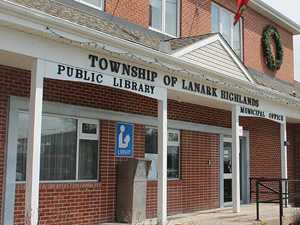
Address
75 George Street, 2nd Floor,
Lanark Village, ON K0G 1K0
(Wheelchair Accessible)
Phone
Website
Hours of Operation
Sunday & Monday
CLOSED
Tuesday
10:00 AM – 7:00 PM
Wednesday
1:00 PM – 4:00 PM
Thursday
10:00 AM – 1:00 PM
Friday
1:00 PM – 6:00 PM
Saturday
10:00 AM – 1:00 PM
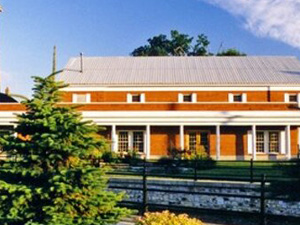
Hours of Operation
Sunday
12:00 PM - 3:00 PM
Monday
10:00 AM – 5:00 PM
Tuesday - Thursday
12:00 PM – 8:00 PM
Friday
10:00 AM – 5:00 PM
Saturday
10:00 AM – 3:00 PM
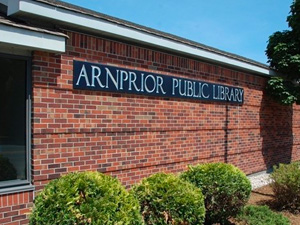
Address
21 Madawaska Street,
Arnprior, ON K7S 1R6
Phone
Website
Interested in represnting the Township of Lanark Highlands on the Arnprior Library Board?
Apply Today! Library_Board_Application_-_2020.pdf
Application deadline: January 11th, 2021 @4:00pm
Hours of Operation
Sunday
CLOSED
Monday - Thursday
12:00 PM – 8:00 PM
Friday - Saturday
10:00 AM – 5:00 PM
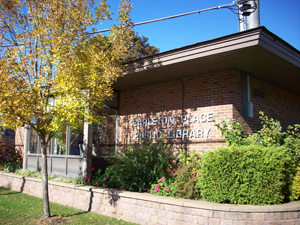
Address
101 Beckwith Street,
Carleton Place, ON K7C 2T3
Phone
Website
Hours of Operation
Sunday
CLOSED
Monday - Thursday
10:30 AM – 8:00 PM
Friday - Saturday
10:00 AM – 5:00 PM
Our History
In 1812, The British Government designated all of Lanark County as a potential landing point for European immigrant settlers. With the establishment of Perth as a military town in 1816, Lanark Township, Dalhousie Township and North Sherbrooke Township were opened for even greater settlement in 1820. From the outset, Lanark Village was designated to be the chief local administrative base for Northern Lanark. Lavant and Darling were also opened for settlement over the following 20 years, in order to accommodate the increasing number of immigrants from the British Isles.
The earliest settlers were unemployed Scots who left the overpopulated areas of Glasgow and Lanarkshire, following the Napoleonic war. In 1820, approximately 400 families arrived in Lanark Village, bringing with them skills in cotton weaving, carpentry, blacksmithing and shoemaking. A similar influx of Irish settlers arrived during the 1830's and 1840's. However, the growth of the area was somewhat impeded by the muddy, rocky terrain and steep slopes, which prevented easy travel. As a result, many settlers opted to reside in Perth, unwilling to make the dangerous trek to Northern Lanark.
Of the settlers who did arrive in the Village, all males over 21 years of age were granted 100 acres divided up using the traditional grid system - a grid which is still evident in the current land use pattern and property boundaries. Although the intention of the original settlers were to farm each parcel of land, it soon became apparent that the only lands that could be cultivated were those located in floodplains, along rivers or adjacent to lakes. Consequently, most settlers opted to perform timber-related activities instead. Early industrial activity typically included grist mills, flour mills, pork-packing and tanning establishments - soon followed by the introduction of maple syrup operations, lumbering, saw mills, furniture activities and fishing.
1857
The Crotch Lake disaster caused a flood from Crotch Lake to the Ottawa River. Many of the bridges across the Mississippi River were swept away, including all three in Dalhousie and one in North Sherbrooke Townships.The flood also washed away the Currie's grist mill at the head of Dalhousie Lake (one of the first to be built and operated on the Mississippi River).
1862
The Village of Lanark officially separated from the Township of Lanark.
1883
The Township of Lavant separates from the Township of Dalhousie and North Sherbrooke
1917
A fire destroyed the Clyde Woolen Mills - the areas largest industry and employer.
1919-1920
The Hydro Electric Power Commission constructed a Hydro Plant at the High Falls, upstream from Dalhousie Lake. The construction employed over 200 men from the area.
1959
A catastrophic fire in the Village destroyed 43 buildings (including the Town Hall, the Library, Memorial Clock and Legion Hall), leaving more than 100 people homeless, and caused $1.5 million in damage. It is a commonly held view that the fire had a profound psychological impact on the spirit of the people of Lanark, causing a temporary depression.
1975
Lavant Township amalgamates with Dalhousie and North Sherbrooke Township to form the "Township of Lavant, Dalhousie and North Sherbrooke".
1997
May 14 - Lavant Dalhousie and North Sherbrooke Township, Lanark Township and Lanark Village amalgamate to form North West Lanark.
July 1 - North West Lanark Township and Darling Township amalgamate to form 'THE TOWNSHIP OF LANARK HIGHLANDS".
1998
An ice storm affecting much of Eastern Ontario and Southern Quebec created a national emergency. Thanks to the generosity of people, businesses and municipalities outside the affected area, normality returned to Lanark Highlands after approximately three weeks. Despite an absence of electricity for up to three weeks, and the considerable destruction of trees and forests, the incident was widely viewed as a unifying experience for the township.
Flooding occurred along the Clyde and Mississippi Rivers. An emergency was declared. Flooding caused considerable strife for a number of weeks.
Roads
ROAD EMERGENCY PHONE NO.
613-264-7329
Please call this number ONLY in case of a road related emergency
or potential danger that requires immediate attention.
Hours of operation
Public works employees work varying hours depending on the season.
Summer Hours:
Mid-April to the end of October
Monday to Thursday
7:00 a.m. – 5:30 p.m.
Winter Hours:
Beginning of November to mid-April
Monday to Friday
7:00 a.m. – 3:30 p.m.
Gravel ResurfacingMay/June/July
Calcium – Class 4 & 5 Gravel Roads
(Class 6 Roads DO NOT receive calcium)June/July
Road Side Grass MowingJuly
Roadside Brushing Various locations throughout the year
GradingAs required
(varies by traffic volumes/types, quality of road base, moisture content/rainfall and presence of calcium)
Lanark Highlands Township has adopted the Provincial "Minimum Maintenance Standards for Municipal Highways" Reg. 298/02, as the standard for year-round township road maintenance. Under the Municipal Act, these benchmarks were adopted to standardize levels of service for various classes of roads throughout the Province, and to specify reasonable response times to maintain or correct deficiencies on the roadways depending upon their class. Provincial, county, and municipal roads are classified differently within these standards based on Posted or Statutory Speed Limit and Annual Average Daily Traffic (AADT.)
Winter maintenance activities and priorities are based on the roadway classification and the associated level of service, as well as legislated hours of work, manpower and municipal budget.
Class 4
Speed Limit 80 kph (500 – 999 vehicles per day)
Class 5
Speed Limit 60 kph (50 – 499 vehicles per day)
Class 6
Speed Limit less than 80kph (0 – 49 vehicles per day)
Class 6B
Routine seasonal maintenance only (no winter maintenance)
Class 6C
No routine maintenance or inspection, use at own risk.
Restricted loads are usually in effect from March 1st to mid-May. Please check the local newspapers, the township web site or call 613-259-2398 to confirm schedule.
Please call the Township Office at 613-259-2398 to report a streetlight that is out/cycling/flickering. We will need the pole number, the closest civic address number, and the road name.
New home construction requires an entrance and a civic address application to be completed before a building permit will be issued. You can apply for these permits at the Township Office in the Public Works Department.
Entrance Permit and Costs
- Entrance Permit - $113
- Entrance Permit if culvert is required - $226
Civic Address & Post Application and Costs
- Civic Addressing Application
- Civic Address Sign & Post $96.05 (includes HST)
- Replacement Sign only $45.20
- Replacement Post only $62.15
Current Road Closures and Other Road Related Information
Finance
2025 Budget
Council approved the 2025 Budget on April 22, 2025.
Budgets
Financial Statements
Asset Management
Township of Lanark Highlands Asset Management Plan
Appendix A Summary Tables - Bridges
Appendix A Summary Tables - Culverts
Taxes
FOR INFORMATION
Contact: Donna Schonauer
Phone Number: 613-259-2398 ext 229
Email:
Lanark Highlands property taxes consists of residential, commercial, industrial and other tax classes, are the Municipality's main source of revenue, and allow us to continue to provide the important municipal programs and services you value and expect. For more information on property taxes click here
Fire Department
In an Emergency, always call 9-1-1
Lanark Highlands Fire Department
75 George Street, Box 340
Lanark, Ontario K0G 1K0
Office Hours
Monday-Friday 9:00 a.m. – 4:00 p.m.
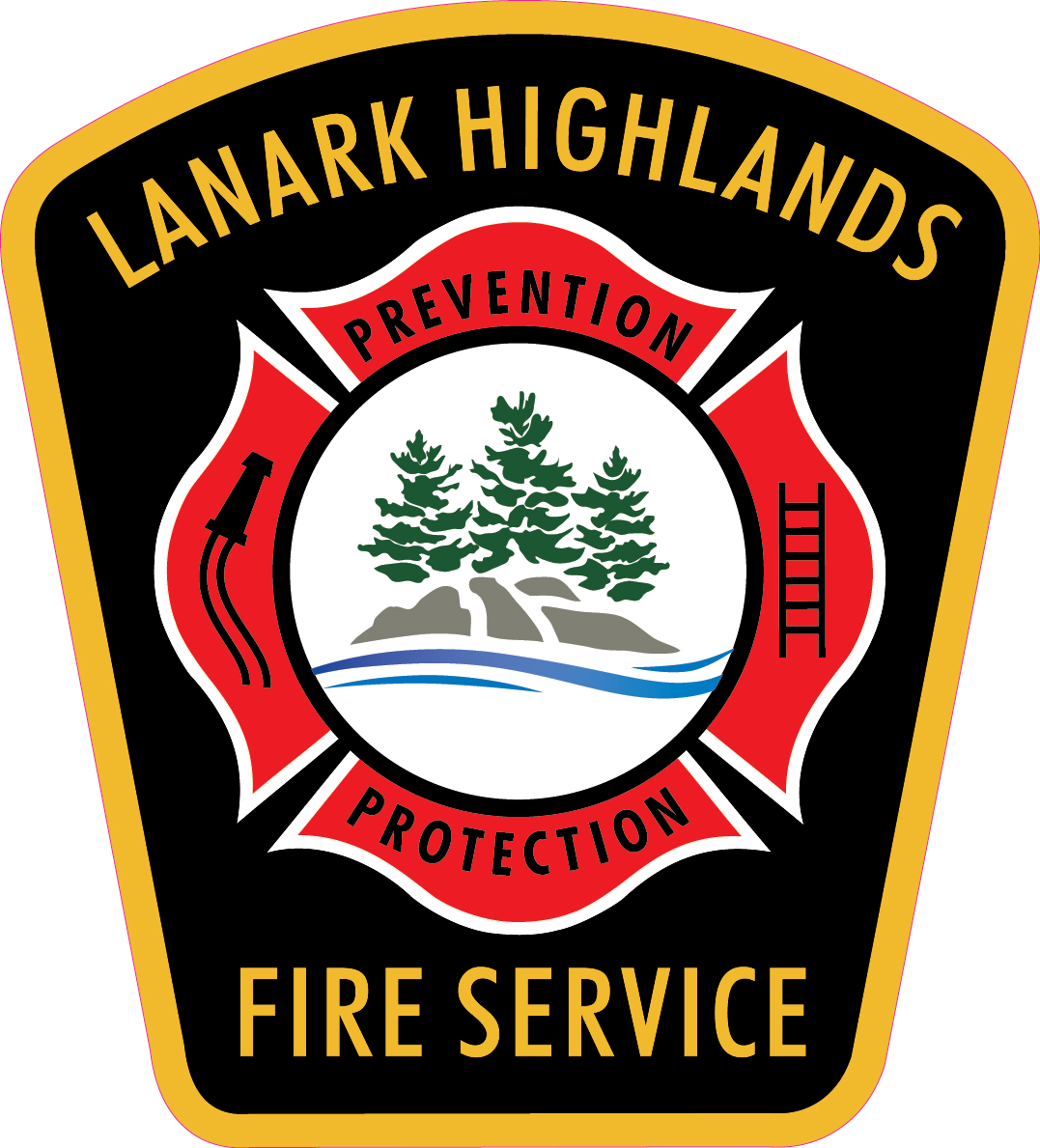
The Lanark Highlands Fire Department consists of 70 highly trained volunteers under the direction of a full time Fire Chief. The Lanark Highlands Fire Service was formed in 1997 with the amalgamation of 5 individual departments. (presently)
- Lanark Village (Station #1)
- Lanark Township (station #2)
- Lavant Dalhousie and North Sherbrooke Township (Station #3)
- Darling Township (Station #4)
The Lanark Highlands Fire service is one of nine municipalities within Lanark County and are part of the Lanark County Mutual aid System. We have automatic aid and fire service agreements in place with Neighbouring municipalities.
The municipalities of Drummond North Emsley and Tay Valley to the south west/east, McNab Braeside to the north east, Lanark Highlands covers 1,048.83 square kilometres. The township boarders two other counties, Renfrew to the north and Frontenac to the west.
Fire Permits
- Fire Permits are available for purchase ONLINE.
- Fire permits are required for ALL burning.
- Fire Permits are valid ONLY for the year of issue.
- Fire permits must be renewed prior to burning.
- Please call 1-844-465-0303 to initiate a burn event. Information such as Fire Risk and Fire Ban status will be advised in the message.
- You must call ahead to initiate fires which are larger than 3.25 feet (1 m) in diameter. Small recreational fire pits DO NOT require activation.
- Cost: $5.00
PLEASE NOTE that if residents are unable to purchase a burn permit online, Township staff is available to provide assistance, either by phone at 613-259-2398 ext. 242 or in person at our Township Office.
April 1st – October 31st – Provincial Fire Season
As per section 2 of Ontario Regulation 207/96, no person shall start or tend a fire outdoors of a restricted fire zone during the fire season unless the person has a permit issued under subsection 5(1) and ALL of the following conditions are met:
- The person is burning piled wood, brush, leaves, or discarded wood products
- A responsible person is available to tend the fire until it is extinguished
- The material is burned in a single pile that is less than 6.5 feet in height and is less than 6.5 feet in diameter
- The fire is started no earlier than two hours before sunset and is extinguished no later than two hours after sunrise the following day.
- The fire is at least 6.5 feet from any flammable materials
- The person tending the fire has tools or adequate water to contain the fire, within the fire site. O. Reg. 230/00 s. 1.
November 1st – March 30th
A fire constructed to the following standards:
- The person is burning piled wood, brush, leaves, or discarded wood products
- A responsible person is available to tend the fire until it is extinguished
- The fire is at least 6.5 feet from any flammable material
- The site of the fire is bare rock or other non-combustible material
- The space above the 3.25-foot area around the fire is at least 10 feet from vegetation
- The fire does not exceed 6.5 feet in height and 6.5 feet in diameter
- The person in control of the fire has sufficient means to extinguish the fire
Cost: $5.00
Fire Permits are available to purchase ONLINE.
If assistance is required to purchase a burn permit, please contact Township staff by phone at 613-259-2398 ext. 242 or in person at our Township Office.
PLEASE NOTE that the Township of Lanark Highlands will no longer be offering the purchase of Burn Permits at remote locations.
Fire Permits can be renewed annually by visiting the BurnPermits website
Fire Permits are valid for a calendar year (January 1 - December 31)
For further information please contact the Lanark Highlands Fire Service @ 613 259-2398 from 08:30-4:30 Monday-Friday
Fire Safety and Prevention
Carbon monoxide (CO) is an invisible, tasteless and odourless gas that is produced when fuels such as propane, gasoline, natural gas, heating oil and wood do not burn completely in fuel-burning appliances and devices, such as: furnaces, fireplaces, hot water heaters, stoves, barbeques, portable heaters, generators and vehicles.
Exposure to CO can cause headaches, nausea, dizziness, confusion, drowsiness, loss of consciousness and even death.
Residential buildings that have a fuel-fired appliance, a fireplace and/or an attached garage MUST have working carbon monoxide alarms. A CO alarm should also be installed on every floor of your home.
CO alarms should be tested monthly – this is easily done by pushing the TEST button. Batteries should also be replaced at least once per year.
Be sure to check the expiration date of all CO alarms in your residence. It is recommended that CO alarms are replaced every 7-10 years. If there is no expiration date or you are unsure of your alarm’s expiration date, the alarm should be replaced.
As per the Ontario Fire Code, a CO alarm MUST meet one of the following standards:
• CSA-6.19, Residential Carbon Monoxide Alarming Devices
• UL 2034, Single and Multiple Station Carbon Monoxide Alarms
Be sure to read the packaging of the CO alarm to make sure it lists one of these standards. Always follow the manufacturer’s instructions on how to correctly install your CO alarm.
For detached homes and townhouses CO alarms must be installed in any hallway immediately outside of bedrooms, and if applicable, in any basement hallway immediately outside of bedrooms.
In apartment and condo buildings CO alarms must be installed in any area or hallway immediately outside of bedrooms if the apartment or unit contains a fuel-fired appliance. If the apartment or unit shares a wall, floor or ceiling with a service room containing a fuel-fired appliance or a parking garage, CO alarms must be installed in any area or hallway immediately outside of bedrooms.
Landlords are responsible for:
• Installing and maintaining CO alarms in their rental units
• Testing CO alarms in rental units in the following situations: annually; when the battery is replaced; when changes are made to the electric circuit; or there is a change of tenancy.
It is against the law for tenants to remove the batteries or tamper with CO alarms in any way.
Safety Tips:
• Remove vehicles from the garage immediately after starting.
• Shovel snow away from exhaust pipes, dryer vents and intakes for fuel burning appliances.
• Use generators or other gas equipment in a well-ventilated location, ideally outdoors away from windows, doors or vent openings.
• Book an annual inspection and cleaning for furnaces, chimneys and fireplaces; gas dryers; stoves; and any other fuel-burning equipment.
• Never use gas appliances such as ranges, ovens or clothes dryers to heat your home.
• Never use a barbecue or portable fuel-burning camping equipment inside.
CO Alarms - It’s the Law Ontario
Is Your Wood Stove Safe?
Improperly installed and maintained wood stoves and fireplaces can lead to dangerous conditions that put you, your family, and neighbours at risk.
Follow the rules – When purchasing a new wood stove or fireplace insert, look for the mark of an accredited certification agency that ensures the product has been tested and meets established safety standards.
Check with your local building department and obtain any necessary permits prior to installing a wood stove, fireplace insert, or chimney. Always follow the manufacturer’s installation instructions.
The Ontario Fire Code requires homeowners to ensure that their home heating appliances and chimneys are safe. This requires periodic inspections and maintenance.
Tips for maintaining your wood burning appliance
- Inspect and Clean your Chimney
- Check your chimney and clear any obstructions at the start of the heating season, and make sure damper controls work properly to keep smoke and toxic gases from building up inside the home.
- Check chimneys and flue pipes often for creosote and soot build-up and clean to prevent a chimney fire.
- Your chimney may have problems you can’t see. If in doubt, consult a WETT (Wood Energy Technical Training) certified chimney sweep.
- Cap It Off
- Maintain an appropriate chimney cap on top of your chimney to protect against damage from rain or snow.
- Spark screens should be inspected regularly to make sure smoke can vent properly.
- Check Stove Pipes and Connections
- Ensure all joints in flue pipes are securely fastened with at least 3 screws. Where flue pipes are joined together, the small (crimped) end should point toward the appliance.
- Protect Floors and Walls from Heat and Sparks
- Keep combustible materials a safe distance away from wood stoves and fireplaces.
- Always use a properly fitting screen for your fireplace.
- Consult a WETT certified chimney sweep if walls get too hot.
- Burn Dry Wood
- Burn properly dried well-seasoned wood to reduce the risk of excessive creosote build-up from inefficient burning or smoldering fires.
- Store wood outdoors, stacked in an open area or shed away from the house or deck to provide good air flow that will assist drying.
- Remove Ashes Safely
- Allow ashes to cool fully before cleaning them from your fireplace or wood stove.
- Use only metal, non-combustible containers to remove ashes from the appliance.
- Take them outside immediately and store well away from buildings on a non-combustible surface.
- Install Carbon Monoxide Alarms
- All homes with fuel-fired appliances should have a carbon monoxide (CO) alarm. Check with your fire department or municipal office regarding Building Code and municipal by-law requirements.
In Ontario, all residences must have a working smoke alarm on every level AND outside every sleeping area.
If your home or residence was built after 2014 you must have a working smoke alarm on every level and IN every sleeping room. The smoke alarms must be interconnected, have a battery backup (that lasts for at minimum 7 days if power is lost) AND have a visible strobe light.
For Rental Units it is the landlord’s responsibility ensure that there are working smoke alarms in each unit. Renters are responsible for testing smoke alarms once monthly and to report any issues to their landlord immediately.
Smoke alarms must be tested monthly – this is easily done by pushing the TEST button. Batteries should be replaced at least once per year.
Be sure to check the expiration date of all smoke alarms in your residence. It is recommended that smoke alarms are replaced every 7-10 years. If there is no expiration date or you are unsure of your alarm’s expiration date, the alarm should be replaced.
For false alarms, use the HUSH button – IT IS AGAINST THE LAW TO DISABLE A SMOKE ALARM. If the alarm is beeping, try cleaning the alarm or replacing the battery. Move or replace the alarm if it is too close to a kitchen, bathroom or heat register.
Replace defective smoke alarms as soon as possible
Types of Smoke Alarms:
Ionization – Fastest type to respond to flaming fires.
Photoelectric- Fastest type to respond to a slow smoldering fire and white or gray smoke, less prone to nuisance alarms from cooking, mist or steam from showers.
Quick Tips:
• Smoke alarms must be installed on or near the ceiling, be sure to follow all manufacturers’ instructions.
• Upgrade to interconnected smoke alarms – if one goes off, they all go off, giving warning wherever you are in your home.
• Choose hardwired smoke alarms that require a backup battery or alarms with a 10-year sealed battery.
• Sleep with bedroom doors closed.
Portable fire extinguishers can help to save lives and property by extinguishing or helping to contain small fires until the fire department arrives.
The number one priority in any fire is always for residents to get out safely – Fire can grow and spread quickly – Please call your local fire department immediately for any fire.
When to use a Fire Extinguisher:
- Everyone has safely exited the building.
- When a fire is contained to a small area, such as a wastebasket.
- The fire is not growing.
- The fire department has been called or is being called.
- The room is not filled with smoke.
Types of Fire Extinguishers:
- Class A – Ordinary combustibles (wood, paper)
- Class B – Grease, gasoline and oils
- Class C – Burning electrical wires
Select a multi-purpose extinguisher labeled ABC which can be used on all types of home fires. Purchase an extinguisher that is large enough to put out a small fire, and light enough to easily use. The fire extinguisher should carry the label of an independent testing laboratory (CSA or ULC). Fire extinguishers should be installed near an exit, in a visible and accessible location. Always follow the manufacturer’s directions for operating and taking care of a fire extinguisher. The pressure gauge should be checked once monthly.
It is safe to use a Fire Extinguisher if:
- The fire is contained to a small area and is not spreading beyond the area immediately surrounding it.
- There is an unblocked escape that you can use where the fire won’t spread.
- You have read and understand the operating instructions and are confident using the fire extinguisher.
How to use a Fire Extinguisher:
Stand approximately 2.5 metres (8 feet) from the fire and keep your back to a clear exit. If the room begins to fill with smoke, leave immediately staying low until safely outside.
To operate a fire extinguisher, remember the word PASS
- Pull the pin, and hold with the extinguisher nozzle pointing away from you. Give a test squeeze to make sure the extinguisher is working properly before approaching the fire.
- Aim low and point the extinguisher at the base of the fire.
- Squeeze the lever slowly and evenly.
- Sweep the nozzle from side to side.
IF THE FIRE DOES NOT IMMEDIATELY GO OUT, EXIT THE AREA AT ONCE
How to Build a Safe Incinerator
If you burn forest litter or debris often, build and use a good incinerator.
- Select a site at least five metres from anything that could catch on fire, like trees, overhanging branches, or piles of debris. Clear an area two metres around the incinerator down to mineral soil.
- Use a metal barrel in good condition
- A heavy metal mesh must be put on top of the incinerator. Mesh size must be less than five mm. Weight the screen with a rock or brick to stop it from falling off your incinerator. Without a mesh cover, a hot fire can spread burning sparks.
- Material will burn more quickly and cleanly if the incinerator has good air flow. To create this, punch holes about seven centimeters above the bottom of the barrel. Punch a few more holes slightly higher and insert steel rods or pipes to support the material to be burned.
- Keep a shovel, rake and water nearby.
- Monitor any fire burning in the incinerator.
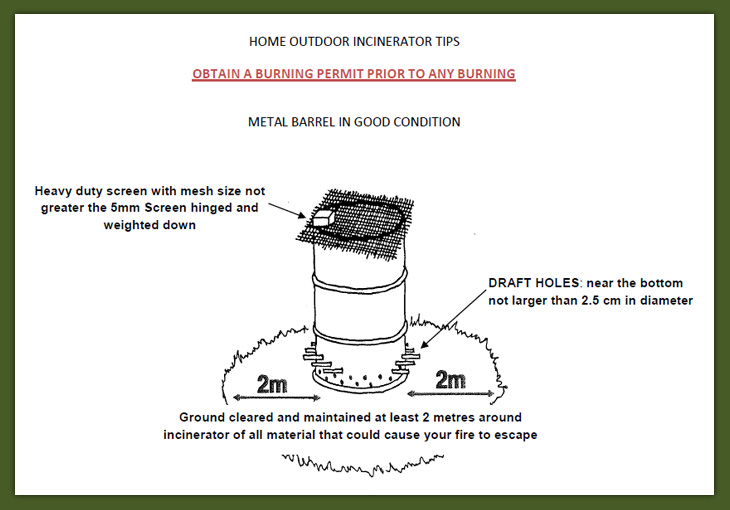
Always follow safe campfire practices to prevent your campfire from starting a forest fire. Remember, you could be held responsible for the cost of putting out the forest fire, and for any property damage.
Choose your site carefully
Select a site with easy access to water, sheltered from prevailing winds. Look for a patch of sand or gravel (mineral soil). An area of bedrock is even better.
Your fire should be at least three metres away from any log, stump or overhanging tree, and 15 metres away from any buildings or forest debris that might catch fire. If you make a circle of rocks around your fire make sure the rocks to not hide hot coals after you leave.
Preparing the site
Start by cleaning a one metre space around your campfire site. Remove all pine needles, grasses, leaves and twigs. Scrape away the surface area, right down to mineral soil.
Keep you fire small. You can always add more fuel as you need it. A smaller fire will keep your cooking tools from blackening and let you get close enough to cook. Remember that the forest is no place for a bonfire, and a small fire is easier to control and put out.
Stay nearby
Never leave your campfire unattended. Every person who starts a fire outdoors must:
- take all reasonable steps to keep the fire under control;
- ensure that responsible person is tending the fire at all times;
- drown the fire before leaving the site of the fire for any period of time whatsoever.
How to put your fire out
Begin by thoroughly drowning your fire with water as soon as possible after use. The ground will cool faster and the hazard to surrounding trees or shrubs will be greatly reduced.
Stir the ashes with a stick to uncover hot coals. This will cool the fire faster and allow water to soak in better. Move the rocks to uncover embers.
Drown it again! Make doubly sure the fire is dead out before you leave the site or retire for the evening.
Each year, hundreds of lives are lost because emergency vehicles could not arrive on scene fast enough. Common causes for this are no PIN numbers, private lanes not adequately marked, and lack of access for emergency vehicles.
Tips to allow emergency responders to find your home or cottage:
- Ensure your PIN Number clearly identifies your home or cottage. If you don’t have a PIN number, contact the Township Municipal Office at 613-259-2398 to arrange for installation.
- Ensure laneways and private drives direct responders to your home. It may be necessary to install a second pin number tree or post directing responders down a lane to find your PIN number. If you believe that emergency responders would benefit from this secondary identification, please call the Township office at 613-259- 2398
- Send help to access points that emergency vehicles will arrive by. Provide directions for responders.
- It is the owner’s responsibility to ensure private laneways are plowed with limbs and trees cleared to a minimum width of 6 metres with overhead clearance of 5 metres. Turns and corners must be wide enough to allow trucks to drive directly to the building.
Limited Access May Affect Emergency Response
It is important that a fire truck or ambulance be able to use your laneway when responding to an emergency call at your house or cottage.
The owner of a building in the Township of Lanark Highlands is responsible for the access to the building from the traveled portion of the road to the building.
An access that is not suitable for a large pumper truck or ambulance may affect the effectiveness of emergency personnel responding to an emergency call at that location.
Laneways should be snowplowed and cleared of limbs or trees to a minimum width of 6 metres with a clearance of 5 metres overhead. Any turns or corners must be wide enough to allow the trucks to drive directly to the residence.
Here are some tips offered by the Office of the Fire Marshal and the Township of Lanark Highlands Fire Service on Fireworks Safety to keep you and your family safe:
- Check with your local Fire Department during Fire Bans
- Always follow the label directions
- Never make your own fireworks
- The shooter should always wear protective eye glasses or protection for their hands
- Fireworks are meant for outdoor environments only
- Have an adult present to light them
- Discharge fireworks well away from combustible materials like buildings, trees and dry grass
- Discharge fireworks only if wind conditions do not create a safety hazard
- Always have water handy when lighting fireworks (ie: a garden hose) you can also use sand in a bucket if need be to put them out.
- Only light one at a time. Never attempt to re-light fireworks that have misfired (duds). Wait 30 minutes and then place them in a bucket of water.
- Never throw/point fireworks at other people
- Sparklers burn extremely hot and can ignite clothing, cause blindness and result in severe burns. As the sparkler wire remains hot for some minutes after burnout, it should be immediately soaked in water to avoid injury

75 George Street,
PO BOX 340
Lanark, Ontario
K0G 1K0
613-259-2398
1-800-239-4695
Hours of Operation:
Monday to Friday - 9:00 a.m. to 4:00 p.m.
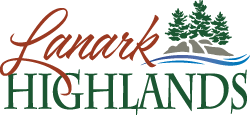

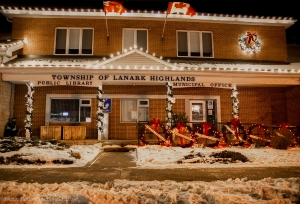

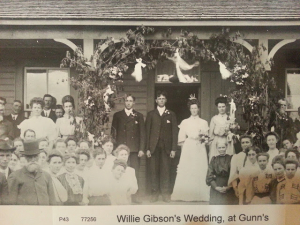
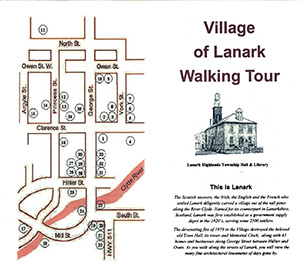 Download the
Download the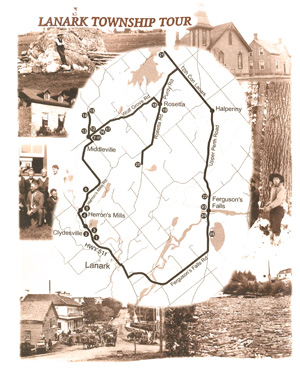 Download the
Download the
